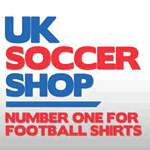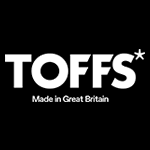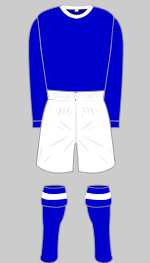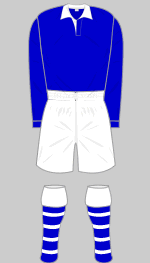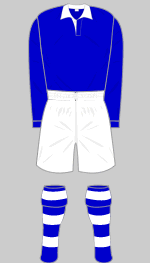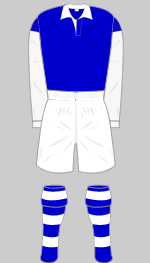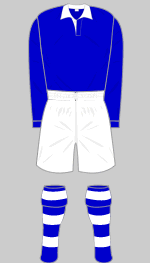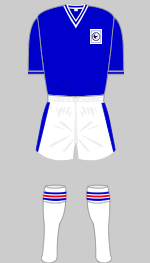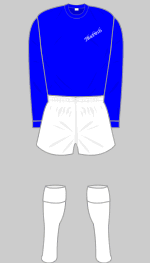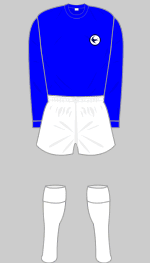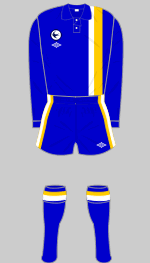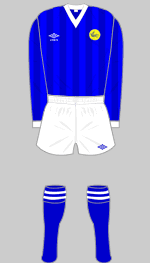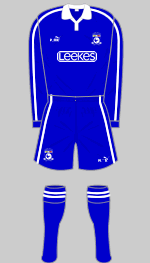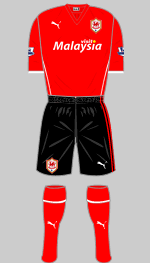Kit History
Riverside
1899
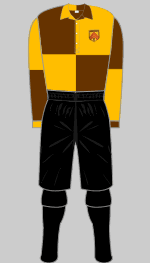
1899-circa1908 a
Cardiff City
1908
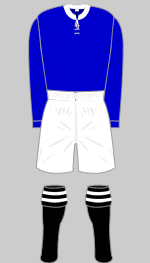
circa 1908-1914 a
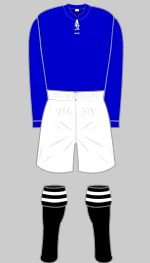
1914-1919 a
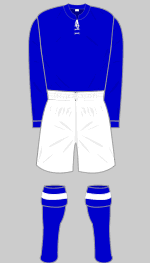
1919-1926 a m
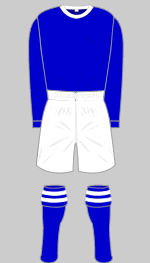
1930-1936 a
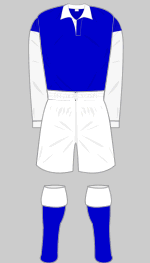
1936-1939 a
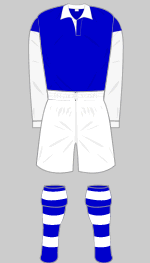
1939-1945 a
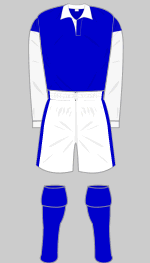
1945-1946 j
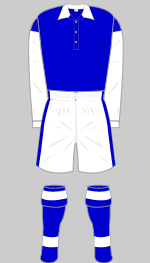
1954-1955 m
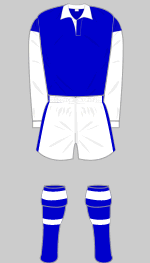
1955-1956 a
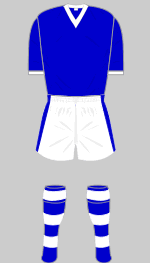
1956-1957 a
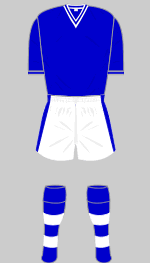
1957-1958 a
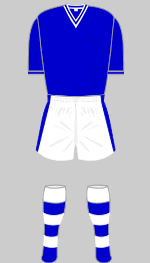
1958-1959 a
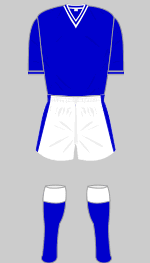
1960-1961 a
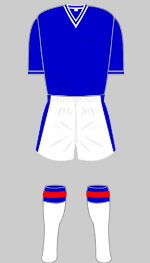
1961-1963 a g
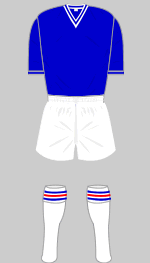
Early 1963-1964 a j
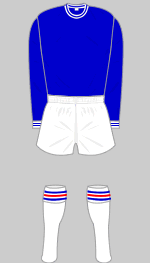
Oct1963-1965 a j
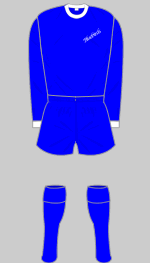
1965-1966 a e
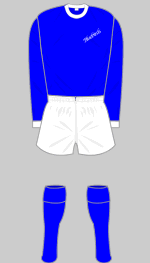
1966-1967 s
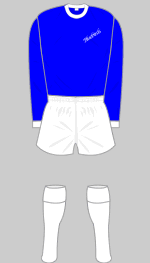
1967-1968 a p
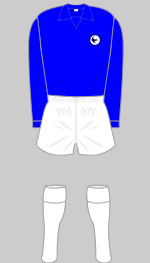
1970-1973 a
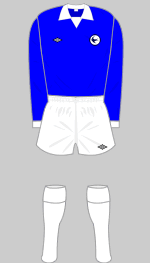
1973-1974 a h
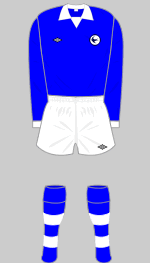
1974-1975 a
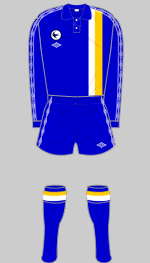
1978-1980 a h n
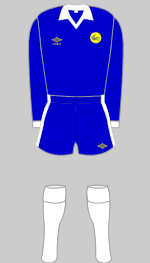
1980-1983 a
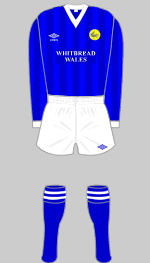
Nov-Dec 1983 k
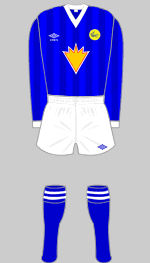
Feb-March 1984 k
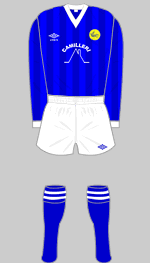
April 1984 k
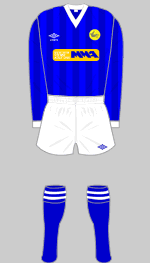
1984-1985 k
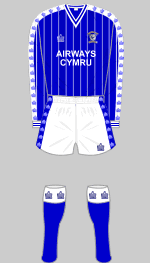
1985-1987 a
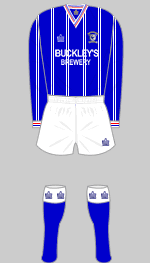
1987-1988 a o
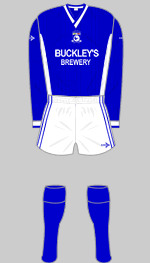
1988-1989 a d u
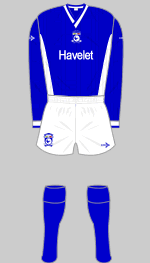
1989-1990 a q
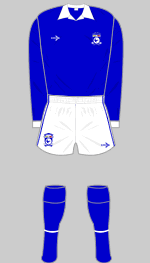
1990-1991 a
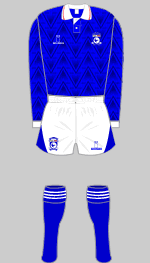
1991-1992 l
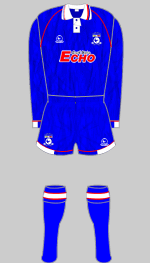
1992-1994 i p
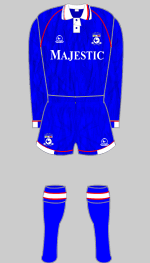
Aug-Sept 1994 p
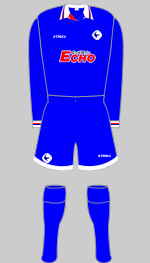
Oct 1994-1995 d l r
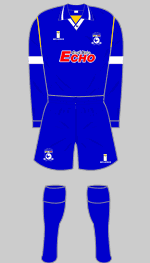
1995-1996 d
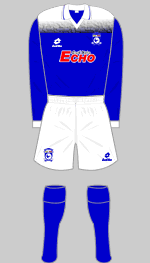
1996-1997 b
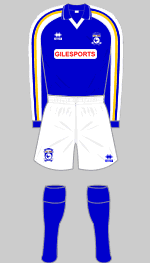
1997-1998 b
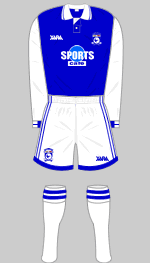
1998-1999 b d
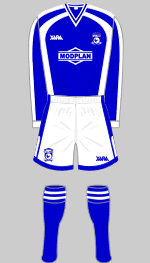
1999-2000 c d
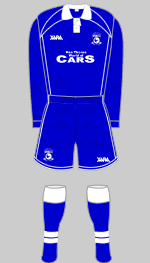
2000-2001 c d
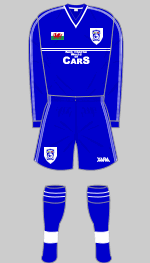
2001-2002 c d s t
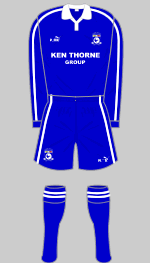
Aug-Oct 2002 r t
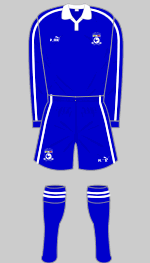
October 2002 r t
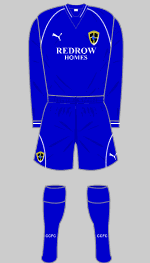
2003-2004 c
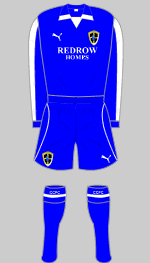
2004-2005 c
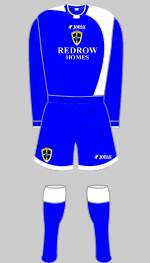
2005-2006 c
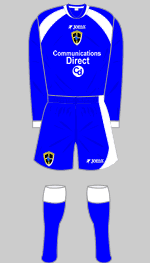
2006-2007 c
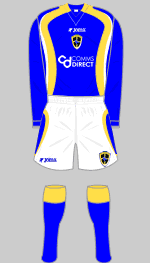
2007-2008 c
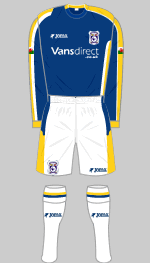
2008-2009 c
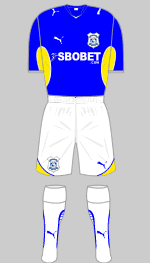
2009-2010 c
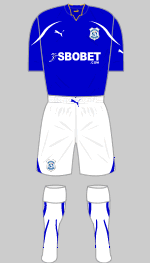
2010-2011 c
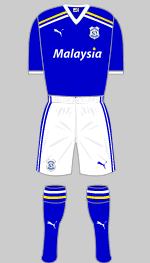
2011-2012 c
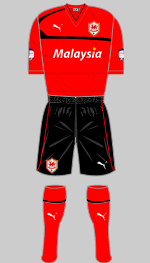
2012-2013 c
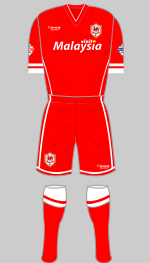
Aug-Dec2014 c
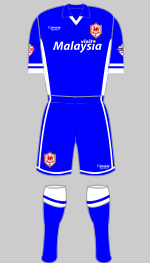
Jan-May 2015 c
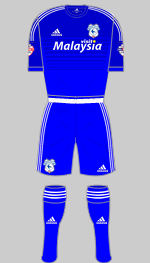
2015-2016 c
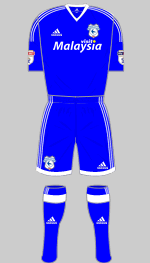
2016-2017 c
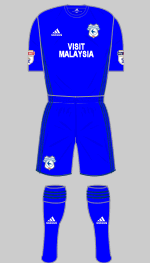
2017-2018 c
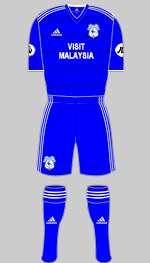
2018-2019 c
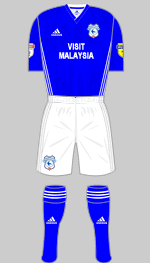
2019-2020 c
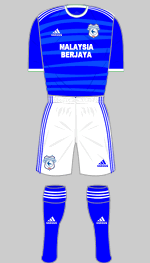
2020-2021 c
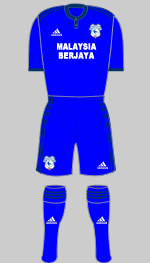
2021-2022 c
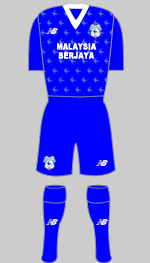
2022-2023 c
Background
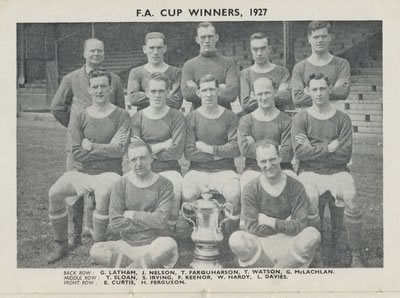 Riverside FC was formed by
members of the Riverside Cricket Club and for some years the team played
in the elegant surroundings of Sophia Park in the centre of the city,
where cricket continues to be played to this day. After a season of friendly
fixtures, they joined the Cardiff & District League in 1900. In
1905 the committee applied to change the club's name to Cardiff City following
the granting of a city charter. Permission was denied as the FA of Wales
considered the club too junior to enjoy such a prestigious title. Three
years later, in 1908, with the club competing in the South Wales Amateur
League, the FAW relented and Cardiff City was borne.
Riverside FC was formed by
members of the Riverside Cricket Club and for some years the team played
in the elegant surroundings of Sophia Park in the centre of the city,
where cricket continues to be played to this day. After a season of friendly
fixtures, they joined the Cardiff & District League in 1900. In
1905 the committee applied to change the club's name to Cardiff City following
the granting of a city charter. Permission was denied as the FA of Wales
considered the club too junior to enjoy such a prestigious title. Three
years later, in 1908, with the club competing in the South Wales Amateur
League, the FAW relented and Cardiff City was borne.
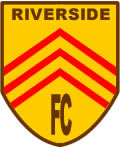 The Riverside FC crest illustrated here is taken from a modern replica shirt and it has not been confirmed if this was worn on the team's early shirts.
The Riverside FC crest illustrated here is taken from a modern replica shirt and it has not been confirmed if this was worn on the team's early shirts.
By the end of the decade City were in desperate need of a proper enclosed ground and began negotiations with the Bute Estate who offered a piece of waste ground previously used as a rubbish tip in the west of the city. The son of the Marquis of Bute, Lord Ninian Crichton-Stuart agreed to act as guarantor to the club and the new ground was named Ninian Park in his honour. In 1910, Cardiff were elected to the Southern League Second Division, rising to the First Division two years later.
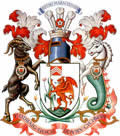 In 1920 The Football League decided to incorporate
the Southern League First Division as the new Third Division. The three
clubs who had finished bottom of Division Two had to apply for re-election.
Cardiff City decided to challenge them for a place in Division Two and
were duly elected, effectively pinching a promotion over their Southern
League colleagues. City went on to finish as runners-up and were promoted
to Division One at the first attempt. The Twenties turned out to be City's
golden period: in 1924 they were runners-up in the League, finishing equal
on points with Huddersfield Town but losing out on the narrowest of goal
average margins - 0.024. The following year, City reached the FA Cup final
but lost to Sheffield United by a single goal. Then, in 1927, the club
won the FA Cup, beating Arsenal 1-0. Famously, this is the only occasion
that the FA Cup has been taken out of England. In both of these games, the coat of arms of the city of Cardiff was worn on the team's shirts.
In 1920 The Football League decided to incorporate
the Southern League First Division as the new Third Division. The three
clubs who had finished bottom of Division Two had to apply for re-election.
Cardiff City decided to challenge them for a place in Division Two and
were duly elected, effectively pinching a promotion over their Southern
League colleagues. City went on to finish as runners-up and were promoted
to Division One at the first attempt. The Twenties turned out to be City's
golden period: in 1924 they were runners-up in the League, finishing equal
on points with Huddersfield Town but losing out on the narrowest of goal
average margins - 0.024. The following year, City reached the FA Cup final
but lost to Sheffield United by a single goal. Then, in 1927, the club
won the FA Cup, beating Arsenal 1-0. Famously, this is the only occasion
that the FA Cup has been taken out of England. In both of these games, the coat of arms of the city of Cardiff was worn on the team's shirts.
There is some difficulty establishing the shade of blue worn in these finals and in the league in the late 1920s. Most photographs suggest they were rather pale but it is likely this is due to the peculiarities of the photographic technology of the period, which could make blue appear lighter than expected.
The end to Cardiff's First Division career came unexpectedly two years later when
the team was relegated and in 1931, they dropped into Division Three
South where they were to stay until after the Second World War. 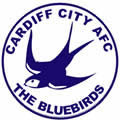
In 1947, the Bluebirds won the Third Division South
Championship by a margin of nine points, fielding ten Welsh players and
one Englishman. In 1952, 52,000 fans crammed into Ninian Park to see City
beat Leeds United and clinch promotion back to Division One. They stayed
at the top level for five years, spent three seasons in Division Two 1957-1960
before returning to 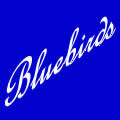 Division One. In 1959 the famous Bluebird crest made its first appearance.
Division One. In 1959 the famous Bluebird crest made its first appearance.
During the Sixties City wore "Bluebirds" embroidered on to their shirts. In 1962 Cardiff dropped back into Division
Two and for the next 13 years, they
languished in the mid to lower reaches of the Second Division although
they narrowly missed out on promotion in 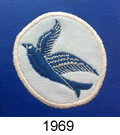 1971. In 1969 the Bluebird crest reappeared, this time without any lettering (and the bird flying upwards rather than down). This simple, elegant motif is perhaps the most popular of all the designs associated with the club and was used for the next 16 seasons. In the 1980s yellow replaced the white background.
1971. In 1969 the Bluebird crest reappeared, this time without any lettering (and the bird flying upwards rather than down). This simple, elegant motif is perhaps the most popular of all the designs associated with the club and was used for the next 16 seasons. In the 1980s yellow replaced the white background.
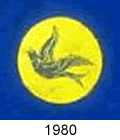 Despite mediocre league performances, City enjoyed
frequent European campaigns by virtue of their participation in the Welsh
Cup. English clubs often won the competition but could not qualify for
the European Cup Winners Cup, their place going to a side based in Wales.
In 1994 Welsh competition was restructured with the introduction of a
national league and this back door into Europe was closed.
Despite mediocre league performances, City enjoyed
frequent European campaigns by virtue of their participation in the Welsh
Cup. English clubs often won the competition but could not qualify for
the European Cup Winners Cup, their place going to a side based in Wales.
In 1994 Welsh competition was restructured with the introduction of a
national league and this back door into Europe was closed.
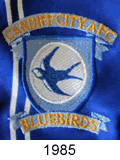 In 1975 City dropped into Division Three for a
single season but during the Eighties and Nineties, they were relegated
and promoted with bewildering regularity. They had two spells in Division Two (1977-82, 1983-85), three in Division Three (1982-83, 1985-86, 1988-90) and two in the Fourth (1986-88, 1990-93). When the League restructured in 1993 City
started off in Nationwide Division Two (third tier) having
won the Fourth Division championship the previous season. Two years later
they were back in the
In 1975 City dropped into Division Three for a
single season but during the Eighties and Nineties, they were relegated
and promoted with bewildering regularity. They had two spells in Division Two (1977-82, 1983-85), three in Division Three (1982-83, 1985-86, 1988-90) and two in the Fourth (1986-88, 1990-93). When the League restructured in 1993 City
started off in Nationwide Division Two (third tier) having
won the Fourth Division championship the previous season. Two years later
they were back in the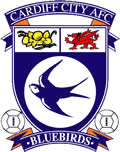 basement.
basement.
A new crest was introduced in 1985, with the club's name and nickname embroidered above and below the main badge. This was updated a few years later into a more elaborate design that incorporated the red dragon and daffodils of Wales as well as the familiar bluebird.
In 2000 the controversial Lebanese entrepreneur Sam Hammam bought the club. Hammam had previously masterminded Wimbledon FC's career in the Premiership before selling his interest. He now set out his goal of taking City to the Premier Division and with promotions in 2001 and 2003, Cardiff returned to the second tier now known as "The Championship". Hammam created controversy by courting the club's infamous hooligan followers, the so-called "Soul Crew."
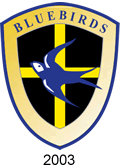 The club introduced a radical new crest for the 2003-04 Championship season: the bluebird was still present but now it appeared against the black and yellow flag of St David, a motif that had grown increasingly popular as a symbol of Welsh national identity.
The club introduced a radical new crest for the 2003-04 Championship season: the bluebird was still present but now it appeared against the black and yellow flag of St David, a motif that had grown increasingly popular as a symbol of Welsh national identity.
In 2005 Hammam hired Peter Ridsdale (who, as chairman of Leeds United, created the financial chaos that almost ruined the Yorkshire club), rapidly making him executive deputy chairman. Negotiations with the City & County of Cardiff Council over a new 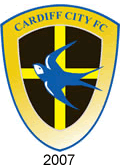 ground had stalled in 2006 because of doubts over the club financial security, when Hammam agreed to a £26m takeover by a consortium headed by Ridsdale. The deal finally went through in December, with financial administration looming, when the consortium agreed to pay Hammam's company an additional £500,000 (with a further £90,000 going to Hammam's brother).
ground had stalled in 2006 because of doubts over the club financial security, when Hammam agreed to a £26m takeover by a consortium headed by Ridsdale. The deal finally went through in December, with financial administration looming, when the consortium agreed to pay Hammam's company an additional £500,000 (with a further £90,000 going to Hammam's brother).
Negotiations with the council were brought to a successful conclusion and a smart new stadium sprang up on the site of the former Leckwith Athletics Stadium, a stone's throw from Ninian Park. The land for the stadium was handed over for nothing by the council, and in return the club pledged to build a community sports facility, to be funded by selling off part of the plot not needed for the stadium.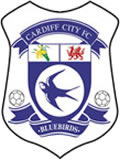
For the 2008-09 season, their last season at Ninian Park, fans were consulted on the crest to be used and came out in favour of reviving the 1985 version. The distinctive shade of the blue shirts worn that season was supposedly based on a swatch taken from a shirt worn in the 1927 FA Cup final. Cardiff successfully warded off a winding up order brought by a mysterious offshore consortium (widely believed to be an instrument of former chairman, Sam Hammam) and reached the FA Cup final for the first time in 81 years.
In the summer of 2009 Ninian Park was finally closed and the club moved into their brand new stadium. The team played in unsponsored shirts until a deal was signed with 777 Bet but these were dropped because the far-east company did not have a licence to trade in the UK. They were replaced by SBOBet from 29 September. Concern over the club's financial future reached crisis in 2010. Fans were encouraged to buy advance season tickets on the understanding that the funds raised would be used to strengthen the squad but in January, the club reneged on this promise. Furthermore it emerged that HMRC had taken out a winding-up order and that the club wanted to use the money raised from the sale of their spare plot to pay off their tax liabilities instead of building the promised community facility. Given this history, supporters were relieved when Ridsdale left after the club was bought by a Malaysian consortium led by Tan Sri Vincent Tan Chee Yioun at the end of the season.
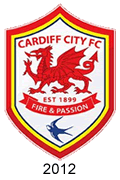 In early May 2012 the board indicated that the owners wanted to change the club's colours from blue to red, considered a lucky colour in the far-east, where Vincent Tan planned to expand the club's appeal. After a storm of protest, the board hastily back-tracked but on 6 June it was announced that the rebranding would go ahead after all. The changes were to be part of a £100m investment programme that would include strengthening the playing squad, upgrading training facilities and expanding the City Ground. It would also pay off the historical £30m debt to Hammam's Langston Corporation, which very nearly brought the club down in 2009. The scale of the proposed investment mollified some supporters and prompted an emotional debate over whether branding should be more important than a club's history.
In early May 2012 the board indicated that the owners wanted to change the club's colours from blue to red, considered a lucky colour in the far-east, where Vincent Tan planned to expand the club's appeal. After a storm of protest, the board hastily back-tracked but on 6 June it was announced that the rebranding would go ahead after all. The changes were to be part of a £100m investment programme that would include strengthening the playing squad, upgrading training facilities and expanding the City Ground. It would also pay off the historical £30m debt to Hammam's Langston Corporation, which very nearly brought the club down in 2009. The scale of the proposed investment mollified some supporters and prompted an emotional debate over whether branding should be more important than a club's history.
If Tan's rebranding risked alienating fans, no-one could complain when the team finally won the Championship title in 2013 with room to spare after years of near-misses and Cardiff City finally took their place in the 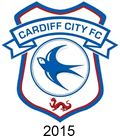 Premier League. Unfortunately they were completely out of their depth and went straight back into the Championship. Tan went on record stating that if the team could bounce back into the Premier League he would "consider" changing their first choice colours back to blue and white. However, over the Christmas period he had a change of heart (which he attributed to his mother's advice) and in the interests of "unity, success and happiness" Tan announced that the team would revert to playing in blue from 10 January. Furthermore, the club crest would be redesigned to give more prominence to the bluebird.
Premier League. Unfortunately they were completely out of their depth and went straight back into the Championship. Tan went on record stating that if the team could bounce back into the Premier League he would "consider" changing their first choice colours back to blue and white. However, over the Christmas period he had a change of heart (which he attributed to his mother's advice) and in the interests of "unity, success and happiness" Tan announced that the team would revert to playing in blue from 10 January. Furthermore, the club crest would be redesigned to give more prominence to the bluebird.
Although going straight back into the Premier League proved beyond the team they did finish second in the 2017-18 Championship to win automatic promotion but were not good enough to stay up and found themselves back in the second tier for 2019-20.
Sources
- a The Official History of Cardiff City FC John Crooke 1992
- b South Wales Echo
- c Cardiff City Official Website
- d David King
- e David Walters
- f www.jumpers4goalposts.com
- g Ralph Pomeroy
- h Alick Milne
- i Tim Mortimer
- j Simon Monks
- k Alan Jenkins
- l Chris Perrett
- m Keith Ellis
- n Steve Perry
- o Adam Jenkins
- p Paul Olsen
- q Phil Griffiths
- r oldfootballshirts.com
- s Senior Tigers Club
- t Matthew Richards
- u Shane Jackson
Crests are the property of Cardiff City FC.


